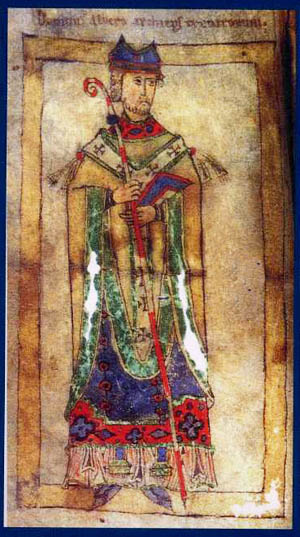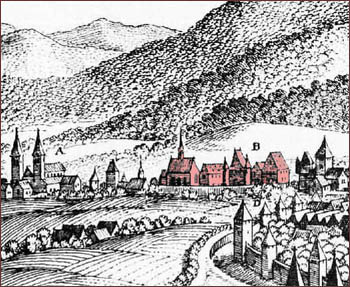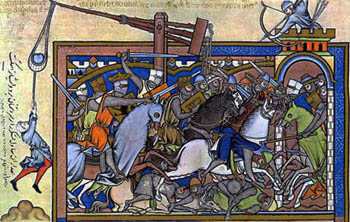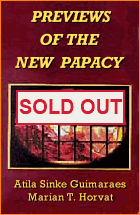History: Personalities
 |
 |
 |
 |
 |
 |
 |
The Warrior-Bishop Albero of Trier
Archbishop Albero von Montreuil - Archbishop of Trier in Lorraine from 1131 to 1152 - was an energetic Prince-Bishop involved in the Church reform, imperial politics and territorial rule.
 This Prince-Prelate often worked with Pope Innocent II, Pope Eugene II and St. Bernard of Clairvaux to defend the independence of the Church.
This Prince-Prelate often worked with Pope Innocent II, Pope Eugene II and St. Bernard of Clairvaux to defend the independence of the Church.
He clashed with the Emperors Henry V and Lothar III, and helped elect King Conrad III of Germany to maintain the Church's freedom.
He lived in the aftermath of the Investiture Controversy of 1076-1122. This conflict between the Church and the German Emperor centered on the question of who should control the appointment of Bishops and invest them with their powers.
The motto of the reform movement was libertas Ecclesiae, or liberty for the Church. Tensions between the temporal and spiritual powers remained high even after the Concordat of Worms in 1122, and Albero quickly established himself as a champion of the papal party.
As a Prince-Bishop, Albero directed the spiritual affairs of the Church in Trier while exercising political rule over the principality. In the latter role, he led and commanded armies of men. His exploits were recorded in Balderich's Gesta Alberonis, or the Deeds of Albero, which presents a fascinating record of a 12th-century clerical hero, a Bishop who took up arms to defend the territory under his political rule and the privileges of the Church.
The conflict with the Count of Namur
In 1140, the Count of Namur, Henry I, broke his oath of fidelity to Albero, his feudal Lord, and approached the city of Trier with 1500 knights to take over the Abbey of Saint-Maximin. Furthermore, Trier was not fortified. Neither ditches nor walls surrounded it, for, having long existed in peace the city was unaccustomed to war. And the Archbishop himself was absent, attending the Royal Court.
The Count might have been able to inflict great damage on the city at the time if God had not averted this evil. Fortunately, Count Frederick von Vianden was then in the city and, meeting with the Count of Namur, through much persuasion made him turn back. He pointed out that Namur would be held in great and perpetual infamy were he to commit such an act against his feudal Lord. In particular, it would be an offense against the King's majesty if the Count of Namur inflicted this sort of evil while the Archbishop was at the Court by royal mandate.
Upon returning from the Court, the Archbishop began to work to keep the peace and to recall the Count from the madness he had undertaken. The Count, nonetheless, burned, plundered and slaughtered throughout the bishopric. And so the Archbishop began to defend himself.
How Lord Archbishop Albero defended his lands
Albero entered the lands of the Count of Namur and twice surrounded the Castle of Mount Rudolf, which seemed in all ways unconquerable, and destroyed it on the second siege. Afterwards, he would build a new castle, called Mount Mercury, out of fear that the forces of Namur might occupy that mountain, which was located in the heart of the Archbishop's territory.
 The archbishop then captured Castle Manderscheid, extremely well fortified by the nature of its location, and retained it up to his death. He took the cities of Gerland and Zolver and either captured or destroyed 30 other fortifications of the Count of Namur. He also captured the city of Echternach, in which the Count maintained the reserves of his army.
The archbishop then captured Castle Manderscheid, extremely well fortified by the nature of its location, and retained it up to his death. He took the cities of Gerland and Zolver and either captured or destroyed 30 other fortifications of the Count of Namur. He also captured the city of Echternach, in which the Count maintained the reserves of his army.
And between the first and second siege of the Castle of Mount Rudolf the Archbishop and the Count met openly on the field of battle. This is how it happened.
When the Archbishop first besieged Mount Rudolf, the Count attacked Pfalzel, a city outside Trier that was ruled by the Archbishop. Setting fire to the Church of St. Mary, he hoped to burn the Archbishop's fortification as well.
When that news reached the Archbishop, he abandoned the siege and hastened with his army through an entire night so that he might make a show of his strength by attacking the unprepared enemy with an unexpected terror.
In fact, the Count learned in advance through his scouts of the Archbishop's approach, turned in flight, and retreated that night to the episcopal village of Wittlich. There he wished to refresh his men and horses, but since he did not find anything there, he burned the whole village.
Proceeding from there to a place near the Abbey of Himmerod, the Count of Namur wished to pause and break bread, for he was famished, but it was announced that the army of the Archbishop was already almost upon him.
And so, the Archbishop overtook the Count and engaged in a fierce battle with him. The Count, turning tail, scarcely managed to flee with the aid of a swift horse, while most of his men were captured and many indeed were killed.
Finally, the Count ran out of strength toward Speyer, where King Conrad, who was then about to go on the Crusade to Jerusalem, managed with great labor to reach the grace of the Archbishop for the Count.
 A treaty was agreed to in January 1147. The Count swore that he would never again take up arms against the Abbey of Saint-Maximin at Trier nor would he or anyone else rebuild the Castle of Mount Rudolf, and would never retake Manderscheid either by force or extortion. Echternach and the Count's other castles and fortifications were given to the Archbishop.
A treaty was agreed to in January 1147. The Count swore that he would never again take up arms against the Abbey of Saint-Maximin at Trier nor would he or anyone else rebuild the Castle of Mount Rudolf, and would never retake Manderscheid either by force or extortion. Echternach and the Count's other castles and fortifications were given to the Archbishop.
On his part, the Archbishop returned to the Count the privileges from the church of Trier the Count had lost with his invasion, excepting those that Archbishop had already given to his own retainers during the time of this conflict.
Thus, Albero took back the Abbey of Saint Maximin and obtained a glorious victory over the Count of Namur. He also accomplished many other things after this.


Archbishop Albero of Trier
He clashed with the Emperors Henry V and Lothar III, and helped elect King Conrad III of Germany to maintain the Church's freedom.
He lived in the aftermath of the Investiture Controversy of 1076-1122. This conflict between the Church and the German Emperor centered on the question of who should control the appointment of Bishops and invest them with their powers.
The motto of the reform movement was libertas Ecclesiae, or liberty for the Church. Tensions between the temporal and spiritual powers remained high even after the Concordat of Worms in 1122, and Albero quickly established himself as a champion of the papal party.
As a Prince-Bishop, Albero directed the spiritual affairs of the Church in Trier while exercising political rule over the principality. In the latter role, he led and commanded armies of men. His exploits were recorded in Balderich's Gesta Alberonis, or the Deeds of Albero, which presents a fascinating record of a 12th-century clerical hero, a Bishop who took up arms to defend the territory under his political rule and the privileges of the Church.
The conflict with the Count of Namur
In 1140, the Count of Namur, Henry I, broke his oath of fidelity to Albero, his feudal Lord, and approached the city of Trier with 1500 knights to take over the Abbey of Saint-Maximin. Furthermore, Trier was not fortified. Neither ditches nor walls surrounded it, for, having long existed in peace the city was unaccustomed to war. And the Archbishop himself was absent, attending the Royal Court.
The Count might have been able to inflict great damage on the city at the time if God had not averted this evil. Fortunately, Count Frederick von Vianden was then in the city and, meeting with the Count of Namur, through much persuasion made him turn back. He pointed out that Namur would be held in great and perpetual infamy were he to commit such an act against his feudal Lord. In particular, it would be an offense against the King's majesty if the Count of Namur inflicted this sort of evil while the Archbishop was at the Court by royal mandate.
Upon returning from the Court, the Archbishop began to work to keep the peace and to recall the Count from the madness he had undertaken. The Count, nonetheless, burned, plundered and slaughtered throughout the bishopric. And so the Archbishop began to defend himself.
How Lord Archbishop Albero defended his lands
Albero entered the lands of the Count of Namur and twice surrounded the Castle of Mount Rudolf, which seemed in all ways unconquerable, and destroyed it on the second siege. Afterwards, he would build a new castle, called Mount Mercury, out of fear that the forces of Namur might occupy that mountain, which was located in the heart of the Archbishop's territory.

The conflict with the Count of Namur started over the Abbey of St. Maximin in Trier, above in pink
And between the first and second siege of the Castle of Mount Rudolf the Archbishop and the Count met openly on the field of battle. This is how it happened.
When the Archbishop first besieged Mount Rudolf, the Count attacked Pfalzel, a city outside Trier that was ruled by the Archbishop. Setting fire to the Church of St. Mary, he hoped to burn the Archbishop's fortification as well.
When that news reached the Archbishop, he abandoned the siege and hastened with his army through an entire night so that he might make a show of his strength by attacking the unprepared enemy with an unexpected terror.
In fact, the Count learned in advance through his scouts of the Archbishop's approach, turned in flight, and retreated that night to the episcopal village of Wittlich. There he wished to refresh his men and horses, but since he did not find anything there, he burned the whole village.
Proceeding from there to a place near the Abbey of Himmerod, the Count of Namur wished to pause and break bread, for he was famished, but it was announced that the army of the Archbishop was already almost upon him.
And so, the Archbishop overtook the Count and engaged in a fierce battle with him. The Count, turning tail, scarcely managed to flee with the aid of a swift horse, while most of his men were captured and many indeed were killed.
Finally, the Count ran out of strength toward Speyer, where King Conrad, who was then about to go on the Crusade to Jerusalem, managed with great labor to reach the grace of the Archbishop for the Count.

As a temporal lord, the Archbishop had an army to defend his lands
On his part, the Archbishop returned to the Count the privileges from the church of Trier the Count had lost with his invasion, excepting those that Archbishop had already given to his own retainers during the time of this conflict.
Thus, Albero took back the Abbey of Saint Maximin and obtained a glorious victory over the Count of Namur. He also accomplished many other things after this.

Adapted from The Deeds of Albero, in A Warrior Bishop of the Twelfth Century,
trans. by Brian A. Pavlac, Pontifical Institute of Mediaeval Studies, 2008, pp.49-52.
Posted July 6, 2013
trans. by Brian A. Pavlac, Pontifical Institute of Mediaeval Studies, 2008, pp.49-52.
Posted July 6, 2013
______________________











